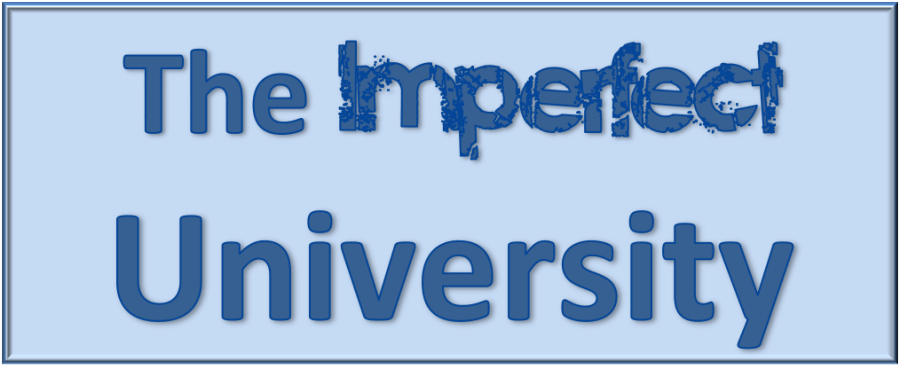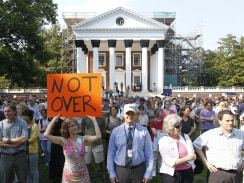University of Virginia: considerable turbulance at the top
A rather topical post for the latest in the Imperfect University series. There have been some extraordinary goings on at the University of Virginia. To the surprise of just about everyone the University’s Board of Visitors (its governing body) decided two weeks ago to remove the President, Teresa Sullivan, after only two years at the helm. Full details of all official statements are available on the University’s website together with links to some of the major news reports on this. It’s a really messy business and must be hugely destabilising for the University.

So why has the Board decided to take this extreme step? According to the statement by the Rector on June 10:
the Board feels strongly and overwhelmingly that we need bold and proactive leadership on tackling the difficult issues that we face. The pace of change in higher education and in health care has accelerated greatly in the last two years. We have calls internally for resolution of tough financial issues that require hard decisions on resource allocation. The compensation of our valued faculty and staff has continued to decline in real terms, and we acknowledge the tremendous task ahead of making star hires to fill the many spots that will be vacated over the next few years as our eminent faculty members retire in great numbers. These challenges are truly an existential threat to the greatness of UVA.
We see no bright lights on the financial horizon as we face limits on tuition increases, an environment of declining federal support, state support that will be flat at best, and pressures on health care payors. This means that as an institution, we have to be able to prioritize and reallocate the resources we do have, and that our best avenue for increasing resources will be through passionate articulation of a vision and effective development efforts to support it. We also believe that higher education is on the brink of a transformation now that online delivery has been legitimized by some of the elite institutions.
We want UVA to remain in that top echelon of universities well into the 21st century and beyond. We want this to be a place that lives up to Mr. Jefferson’s founding vision of excellence. We want it to be a place that attracts the best and the brightest in scholarship, teaching, patient care, and community service.
To achieve these aspirations, the Board feels the need for a bold leader who can help develop, articulate, and implement a concrete and achievable strategic plan to re-elevate the University to its highest potential. We need a leader with a great willingness to adapt the way we deliver our teaching, research, and patient care to the realities of the external environment. We need a leader who is able to passionately convey a vision to our community, and effectively obtain gifts and buy-in towards our collective goals.
The Board believes this environment calls for a much faster pace of change in administrative structure, in governance, in financial resource development and in resource prioritization and allocation. We do not believe we can even maintain our current standard under a model of incremental, marginal change. The world is simply moving too fast.
This would suggest that the Board’s fundamental concern is that change in the University is insufficient both in scale and pace in order to meet the challenges it faces. And that the President therefore has to be replaced with a bolder leader in order to ensure such change happens. It really is a quite remarkable statement. Whilst such events are not rare in other sectors it does seem like extreme step in a higher education context.
Meanwhile, back to the action – The Washington Post reported on a demonstration in support of the ousted President:
Sullivan was forced out after a closed-door meeting of the board. The June 10 announcement that she would resign blindsided Sullivan and ignited a furor at Virginia’s flagship university, founded by Thomas Jefferson in 1819. More than 2,000 people gathered outside the Rotunda on Monday to show their support for Sullivan, who gained wide popularity since taking the job in 2010.
U.Va.’s Faculty Senate and other groups had called for Kington and Rector Helen Dragas to step down as they severely criticized the board’s handling of Sullivan’s removal. Dragas and Kington joined in the behind-the-scenes effort to call for her resignation, and no board members have publicly discussed specific reasons behind the decision.
There is still a long way for this story to go and the New York Times has reported on some other changes on the Board:
In the continuing turmoil after the abrupt ouster of University of Virginia’s president, Teresa Sullivan, on June 10, the university’s vice rector, Mark Kington, and a prominent computer science professor have resigned — and some faculty members say there may soon be enough turnover on the 16-member Board of Visitors that Dr. Sullivan could be reinstated.
Gov. Bob McDonnell, who appoints the board, could fill as many as six seats on the university’s governing body on July 1. In addition to Mr. Kington’s replacement, he has the ability to replace the rector, Helen E. Dragas, whose term is ending. Another member is up for reappointment, two will rotate off the board and an appointment is needed to fill a seat created this year.
On Tuesday, when the board voted 12 to 1 to name Carl P. Zeithaml as interim president, there were two abstentions and one absence, so a shift of six would put the outcome of future votes in question. Furthermore, one member who voted for Mr. Zeithaml’s appointment has said he hopes to undo Dr. Sullivan’s resignation.
There does seem to be a view, at least among Dr Sullivan’s supporters, that these imminent changes to the Board membership could somehow lead to her reinstatement. These appointments though appear to be in the hands of the State Governor and it is not at all clear what he will choose to do nor what effect it will have. But the bigger question the Board will ultimately have to answer is how this radical change can be shown to be in the long term interests of the University. HE institutions are fundamentally concerned with delivering change in the long run and effective stewardship and a concern for real sustainability has to be at the heart of any governing body’s actions. It is simply not clear at this stage how this dramatic step will help UVa deliver its ultimate ambitions.
In considering the fall out from this affair Chronicle also carries an extensive piece and follows up on the specfic issue of appointing a leader who will deliver the kind of “strategic dynamism” which the UVa Board seems to think is lacking:
So what is “strategic dynamism,” and who are its practitioners? Quite the opposite of the methodical, long-term visions found in most universities’ strategic plans, strategic dynamism implies a near-constant “stirring of the pot” within an organization, explains Donald C. Hambrick, a professor of management at Pennsylvania State University’s main campus.
That could mean wild changes in asset allocation within a company’s investment portfolio or a radical alteration of a business’s marketing approach. Proponents of strategic dynamism value the potential rewards of substantial, fast-paced change more than the stability of a gradual strategic evolution, Mr. Hambrick says.
There’s another thing about executives who embrace strategic dynamism: They’re totally in love with themselves, Mr. Hambrick says. In 2007, Mr. Hambrick co-authored a study that found a strong correlation between a chief executive’s level of narcissism and his or her penchant for making frequent changes consistent with strategic dynamism.
The study used five indicators to measure a chief executive’s narcissism, including the prominence of the executive’s photographs in a company’s annual report, the frequency of the executive’s name in company news releases, the disparity between the chief executive’s compensation and that of the company’s second in command, and the frequency with which the chief executive uses first-person-singular pronouns in interviews.
“Having a narcissist for your CEO and engaging in strategic dynamism carries risk,” he continues. “It’s almost axiomatic that if you engage in strategic dynamism and take a big risk, you’re going to have extreme outcomes.”
There is no shortage of criticism that higher education moves too slowly, and there are plenty of trustees and pundits who would say a dose of strategic dynamism is just the kick in the pants the industry needs.
A previous post discussed the issue of who should lead universities and the UVa case gives us a different angle on this. Dr Sullivan is, by all accounts, an outstanding academic with significant experience including four years as provost at the University of Michigan and as executive vice chancellor of the University of Texas system. It seems though that the UVa Board has determined that it needs someone other than an academic. Or perhaps just a different kind of academic.
Will Dr Sullivan be reinstated? Will the University Board appoint a narcissist to replace her? Who knows. However, the turmoil this change has caused will continue to impact on the University for some time to come. It is difficult to predict what the long term consequences will be but in the short term at the very least it is a huge distraction for staff and things aren’t going to get any easier until this matter is resolved.
One footnote to all of this. US press reports on this issue commonly refer to the “ouster” of the President. I find this usage bizarre and for some days thought there was a specific individual being identified as the person who did the ousting rather than the ouster being the event itself.

 Sullivan was forced out after a closed-door meeting of the board. The June 10 announcement that she would resign blindsided Sullivan and ignited a furor at Virginia’s flagship university, founded by Thomas Jefferson in 1819. More than 2,000 people gathered outside the Rotunda on Monday to show their support for Sullivan, who gained wide popularity since taking the job in 2010.
Sullivan was forced out after a closed-door meeting of the board. The June 10 announcement that she would resign blindsided Sullivan and ignited a furor at Virginia’s flagship university, founded by Thomas Jefferson in 1819. More than 2,000 people gathered outside the Rotunda on Monday to show their support for Sullivan, who gained wide popularity since taking the job in 2010.








